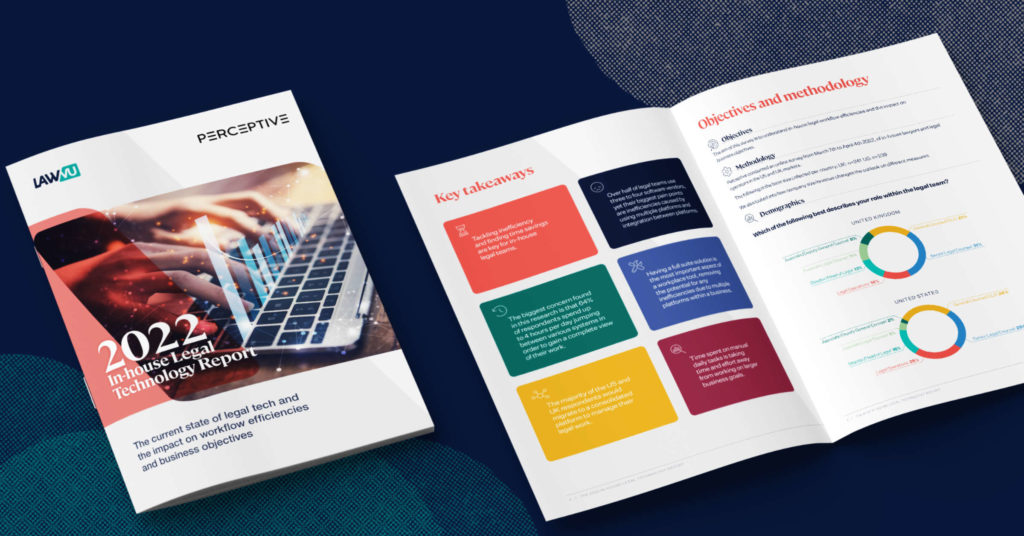New report finds in-house legal teams want to spend more time on the business — they just can’t find the time

Switching between multiple software solutions, time-consuming manual day-to-day tasks, and inefficient systems for managing workloads are all challenges facing in-house legal teams, reducing the time they have available to spend on the wider business.
The 2022 In-house Legal Technology Report: The current state of legal tech and the impact on workflow efficiencies and business objectives delivers a better understanding of how in-house teams use legal technology, the challenges they face, and the implications for legal workflow efficiencies and wider business goals. The research was conducted in nearly 500 in-house lawyers and legal operations professionals*.
In-house legal wants to engage more with the wider business
The key finding of the report is that 92 percent of all respondents believe that time spent on manual daily activities takes time and effort away from working on larger business goals or affects their ability to deliver services promptly. Of those, 67 percent consider their ability to influence major business goals is the factor most affected.
Multiple platforms are causing headaches
The most common pain points affecting legal professionals are those causing a burden on time and a lack of coordination across the legal team and the wider department. The top three pain points are:
- inefficiencies due to multiple platforms (such as duplicate data entry);
- concerns about data and information security; and
- a lack of integration between platforms.
With 90 percent of legal teams using solutions from three or more software vendors to manage their work, it’s no surprise that the biggest pain point was inefficiency due to multiple platforms.
Other pain points identified with current technology are the lack of technology adoption by team members, the inability to collaborate effectively with teams, technology that’s not user-friendly enough, too many platforms to learn and manage, and a lack of overall functionality from technology solutions.
Switching between solutions takes up valuable time
Overall, 77 percent of in-house legal teams spend over one hour a day jumping between different software solutions to gain a complete view of their work and determine priorities. Of those, 39 percent spend three or more hours switching between different applications.
40 to 45 percent of legal professionals are also spending more than three hours per day on:
- team management tasks such as determining workload capacity, the status of individual tasks, and managing internal processes, reported;
- searching through emails or other systems to determine matter history or advice from outside counsel; and
- back and forth with the wider business to gather complete information or update them on the status of legal work.
When the time spent on daily tasks is evaluated, the benefits of having a comprehensive and integrated legal technology solution become clear. Unsurprisingly, the majority of those surveyed indicated that, if given the opportunity, they would migrate to a consolidated platform, such as a legal workspace, to manage their legal work.
Working towards a solution
Having a full suite solution (to remove inefficiencies due to multiple platforms within a legal team and across the business) is considered the most important factor when selecting a workplace tool by a third of all legal professionals surveyed.
The research also reveals several key trends regarding the use of technology in legal departments and the barriers to being a truly connected in-house legal team. These include:
- the common use of software not designed for in-house legal teams;
- the use of multiple different tools for day-to-day work; and
- a desire for a single, consolidated platform
Why are these findings important?
Many lawyers move in-house to be part of a business and contribute to its success, yet many of the inefficiencies they are dealing with daily prevent them from achieving this. Without the right technology, in-house legal teams often experience fragmented and disconnected ways of working, meaning they are less able to deal with the increasing complexities of their work and spend a substantial amount of time on manual tasks.
This research brings to light the inefficiencies in-house legal teams currently face. It highlights that the majority of teams are actively seeking a legal tech solution that provides oversight of all their work and gives time back — time they can spend engaging with the wider business.
Download a copy of the full report to:
- understand how your peers are managing their day-to-day work and what tools they use
- discover the average time spent per day on manual tasks
- compare your ways of working with companies of a similar size
- learn what other in-house legal professionals are looking for in their legal technology solutions
*Research conducted by Perceptive and LawVu from March 7th to April 4th, 2022, in in-house lawyers and legal operators across US and UK markets, in companies of various sizes. The base size collected per country is UK: n=241, US: n=239.
